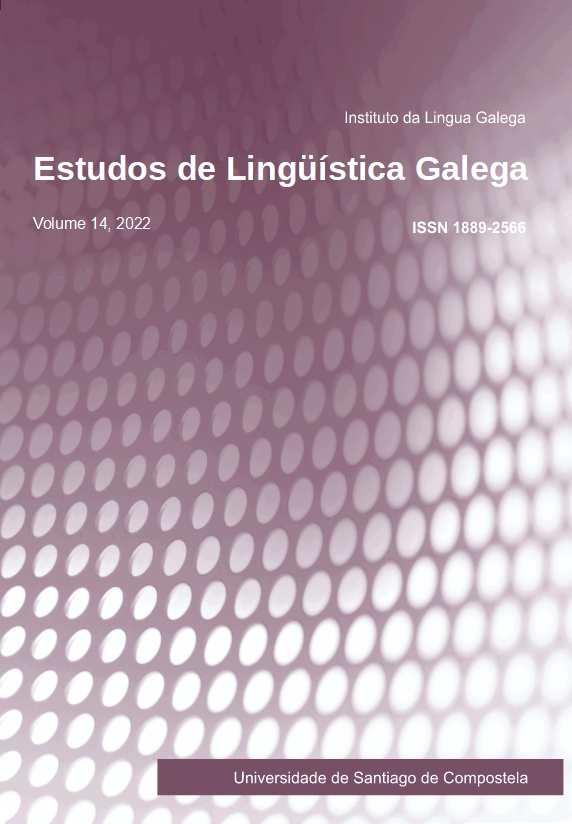Mathematical models and language shift
Main Article Content
Abstract
Keywords:
Article Details
References
Abrams, Daniel M. / Steven H. Strogatz (2003): “Modeling the dynamics of language death”, Nature 424, 900.
Ayestarán Aranaz, Margarita / Justo de la Cueva Alonso (1974): Las familias de la provincia de Pontevedra (Galleguidad y conflicto lingüístico). Sevilla: Instituto de Ciencias de la Familia.
Axelrod, Robert (2006): “Agent-based modeling as a bridge between disciplines”, en Leigh Tesfatsion / Kenneth L. Judd (eds.), Handbook of Computational Economics Vol. 2: Agent-Based Computational Economics. Amsterdam: North Holland/Elsevier, 1565–1584.
Blythe, Richard / William Croft (2010): “Can a science-humanities collaboration be successful?”, Adaptive Behavior 18, 12–20.
Bornkessel-Schlesewsky, Ina / Matthias Schlesewsky (2009): Processing Syntax and Morphology: A Neurocognitive Perspective. Oxford: Oxford University Press.
Castelló, Xavier (2010): Collective phenomena in social dynamics: consensus problems, ordering dynamics and language competition, Tese de doutoramento UIB http://ifisc.uib-csic.es/publications/downfile.php?fid=4001 .
Castelló, Xavier et alii (2008): “Modelling language competition: Bilingualism and complex social networks”, en Andrew D.M. Smith / Kenny Smith / Ramón Ferrer i Cancho (eds.), The evolution of language. Proceedings of the 7th International Conference (EVOLANG7). Singapore: World Scientific Publishing Co., 59-66.
Castelló, Xavier / Lucía Loureiro-Porto / Maxi San Miguel (no prelo): “Agent-based models of language competition”, en International Journal of the Sociology of Language, Special issue on Models and language contact.
Crystal, David (2000): Language Death. Cambridge: CUP.
Fishman, Joshua A. (1991): Reversing Language Shift: Theoretical and Empirical Foundations of Assistance to Threatened Languages. Clevedon, Philadelphia: Multilingual Matters.
Fishman, Joshua A. (ed.) (2001): Can Threatened Languages Be Saved? Reversing Language Shift Revisited: A 21st Century Perspective. Clevedon, Buffalo: Multilingual Matters.
Kabatek, Johannes (1995): Recensión de: Seminario de Sociolingüística da Real Academia Galega (ed.): Estudio sociolingüístico da comarca ferrolá. Fase previa ó Mapa Sociolingüístico de Galicia. A Coruña: Real Academia Galega 1993 (Cadernos de Lingua, Anexo 1), Sociolinguistica 9 (1995), 160–162.
Kabatek, Johannes (2000): Os falantes como lingüistas. Vigo: Xerais.
Kabatek, Johannes (2005): “Über Trampelpfade, sichtbare Hände und Sprachwandelprozesse”, en Thomas Stehl (ed.), Unsichtbare Hand und Sprecherwahl. Typologie und Prozesse des Sprachwandels in der Romania. Tübingen: Narr, 155-174.
Kabatek, Johannes / Lucía Loureiro-Porto (no prelo): “Mathematic models meet linguistic data and vice versa”, International Journal of the Sociology of Language, Special issue on Models and language contact.
Katsumori, Makoto (2010): “Heisenberg on Science, Language, and the Question of Objectivity”, Energeia 2, 1-7.
Keller, Rudi (1990/1994): Sprachwandel. Von der unsichtbaren Hand in der Sprache. Tübingen: Francke.
Minett, James W. / William S.-Y. Wang (2008): “Modelling endangered languages: The effects of bilingualism and social structure”, Lingua 118, 19-45.
Mira, Jorge B. / Ángel Paredes (2005) “Interlinguistic similarity and language death dynamics”, Europhysics Letters 69 (6), 1031–1034.
Mira, Jorge / Luís F. Seoane / Juan J. Nieto (2011): “The importance of interlinguistic similarity and stable bilingualism when two languages compete”, New Journal of Physics 13, http://iopscience.iop.org/1367-2630/13/3/033007/pdf/1367-2630_13_3_033007.pdf.
Mufwene, Salikoko (2004): “Language birth and death”, Annual Review of Anthropology 33, 201-222.
Real Academia Galega. Seminario de Sociolingüística (1995): Usos lingüísticos en Galicia. A Coruña: RAG.
Trudgill, Peter (1972): “Sex, covert prestige and linguistic change in the urban British English of Norwich”, Language in Society 17, 61-88.


